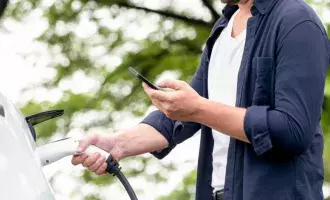As I noted in my previous post, the role of the next-gen consumer in the utilities market is evolving.
In fact, so great is their impact that the UK Government has set out its own vision for energy consumers of the future, stating in its energy White Paper: “Our vision is of a system with consumers at its heart, able to make money or save on bills through using the new technologies net zero will require1."
This sums up the next gen consumer perfectly. It’s their fast-growing environmental consciousness, combined with their increasing comfort around new technology, which is creating a demand for low-carbon, digitally-managed alternatives that’s massively disrupting traditional energy providers.
As well as being technology-minded, they’re open to new concepts. Most importantly, they are willing to put in the work to understand how innovative technology can help them to reduce their environmental impact as well as their energy bills. While they’re in the minority now, what these consumers demand will become the norm within the next few years – that’s a certainty. What is less certain is how providers will step up to meet these demands in an integrated and user-friendly way.
So, let’s look at their expectations in detail.
1. Environment as a priority
The more environmentally conscious consumers become, the more they seek to understand their impact on the environment and the greater their demand for products and services that can help them to reduce it.
The technology that can help them to do this is evolving, too, becoming more affordable and efficient: solar panels, for example, are cheaper2 and can generate more power per square foot3 than ever before.
As more consumers make these demands and adopt these technologies more quickly, the demographics are going to shift. Increasingly, the average consumer looking to adopt new technology won't be as willing to go the extra mile to understand it as the current ones are. They’ll want their integrated carbon-saving technology to arrive oven-ready. The energy supplier, partnership or third-party provider that makes this possible could corner the market.
2. Finding new ways to ensure stability of supply
Renewable energy is criticised for its dependence on the weather and the tides, because these two sources can’t be relied on to provide the consistent flow of generated electricity that’s vital for maintaining grid stability. An unstable grid supply can cause power cuts, leading to lost productivity and inconvenience for customers, and power surges and spikes, which can damage electrical devices and components4.
Developing new technologies and systems to mitigate this is crucial – and some of the proposals are surprisingly simple. For example, one way is for the ever-growing number of electric vehicles (EVs) to act as a charge-discharge component within the grid. At times when electricity demand is high (such as in the evening), EV owners could discharge electricity from their vehicles to bolster the supply in the grid. Conversely, during times of peak wind (for example) when a lot of electricity can be generated, EVs could be used to store the excess.
Essentially, your EV could serve as a massive power pack and, consequently, the grid would become much more flexible.
3. The challenge of reducing consumption
As the UK works to achieve its net carbon zero target by 2050 and replace fossil fuel-burning energy sources with ‘cleaner’ ones, our current capacity for generation won’t be enough to meet national requirements. So, we need to find new ways to generate clean electricity and use alternative heating sources, all while using less.
But in a twist, researchers at the University of the State of Baden-Wuerttemberg and National Research Centre of the Helmholtz Association predict that a household using an EV will double its energy consumption5.
This means that we need to find new ways to reduce consumption or to generate energy differently to the currently centralised model.
The Government’s energy White Paper reaches the same conclusion, stating that “to achieve net zero emissions, we will have to transition completely away from traditional natural gas boilers for heating homes on the gas grid… Electric heat pumps and hydrogen, green gas and shared heat networks all have their part to play6.”
Controlling your smart home’s central heating remotely is nothing new but, as both consumers and government push for a carbon-neutral source of heating, the demand for gas boilers is likely to wane in favour of ground source or air source heat pumps.
While these cost more than traditional boilers (and to retrofit an existing home with a ground pump can require extensive digging), subsidies like the Government’s renewable heat incentive7 mean they’re not unaffordable. Because heat pumps can create heat even at below-freezing temperatures, use very little electricity and don’t depend on burning fuel to create heat8, over time they reduce household bills and carbon emissions substantially.
As the Government pushes forward with its green agenda, it’s expected to consult on whether it’s appropriate to end gas grid connections to new homes, in favour of clean energy alternatives. Organisations will need to consider initiatives such as these when they’re creating their strategic business plans.
4. Microgeneration and energy trading
Home generation through solar panels and, to a lesser degree, wind turbines and hydropower is increasingly popular. The next-gen consumer aspires to become as energy self-sufficient as possible, to reduce their carbon footprint and perhaps even earn income through energy trading.
As energy generation becomes less linear and decentralised, microgeneration plays a key role in ensuring that we meet demand without disrupting the supply. The ability to store energy in batteries or EVs, when it’s available cheaply, and sharing or trading it within your community becomes more widespread. Community energy has a part to play in this: groups tend to have more buying power than individuals and are able to generate more energy to serve their local community while contributing to climate change targets. More community energy groups are being set up, by proactive community members, council initiatives and housing association projects. People are forming themselves into small to medium sized enterprises, looking for a different way of generating and consuming energy.
Becoming a next-gen provider
Right now, the energy industry is failing to consider the customer experience perspective. It works in silos, viewing each component of a consumer’s relationship with energy – consumption, generation and trading – as a separate entity. If we continue down this road, we risk overwhelming the consumer with a glut of apps – one from their EV manufacturer, another to control their heat pump, a third for controlling their smart home, a fourth for selling excess energy generated or stored at home, a fifth for tracking and managing their energy consumption.
Next-gen consumers are going to want their experience of these services to match the seamlessness they’ve come to expect of a banking app or online shop. What’s needed is a partnership of providers, or a third party, to integrate them into a single bundle. Think, for example, of the companies that supply your landline, wi-fi and mobile services and let you manage them all via a single interface. We’re seeing this on a smaller scale: some energy providers have teamed up with car manufacturers, for example, to offer a package that includes a charging bundle when you buy an EV. But this package remains separate from the provider’s heat pump storage product, and EV owners still need yet another provider to install their charging point.
The challenge for the marketplace, therefore, is to step up and offer a comprehensive energy package to the next-gen consumer who aspires to net-zero, to enable them to produce electricity and heat at home, to track their usage and charge their devices at optimal times, and to export excess or generated energy to the grid, or sell to peers – and, crucially, to make it as easy for them as possible.
All of this is extremely complicated, so the company that can simplify the experience for its customers will gain an immediate advantage. But this in itself is difficult. In my next blog post, I’ll explore how product and service development need to evolve to meet the next-gen consumer’s changing demands.

Rupal Patel
Account Leader, Critical Infrastructure
Rupal is a proven leader with a track record of delivering in challenging circumstances without compromising quality or losing sight of the overall business strategy. She has played a fundamental role in transforming the utilities sector and implementing digital and innovation practices and is a recognised source of expertise in the utilities and smart energy industry with over 15 years of experience.
Thinking about your organisation?
References:
[1] https://www.gov.uk/government/publications/energy-white-paper-powering-our-net-zero-future/energy-white-paper-powering-our-net-zero-future-accessible-html-version
[2] https://www.carbonbrief.org/solar-is-now-cheapest-electricity-in-history-confirms-iea
[3] https://www.solarreviews.com/blog/what-is-the-power-output-of-a-solar-panel
[4] https://www.sollatek.com/the-importance-of-stable-power-supply/
[5] https://www.iip.kit.edu/downloads/No_03_062013_How_to_integrate_electric_vehicles_in_the_future_energy_system.pdf, p5
[6] https://www.gov.uk/government/publications/energy-white-paper-powering-our-net-zero-future/energy-white-paper-powering-our-net-zero-future-accessible-html-version
[7] https://www.gov.uk/renewable-heat-incentive-calculator
[8] https://www.renewableenergyhub.co.uk/main/heat-pumps-information/how-a-heat-pump-works/







